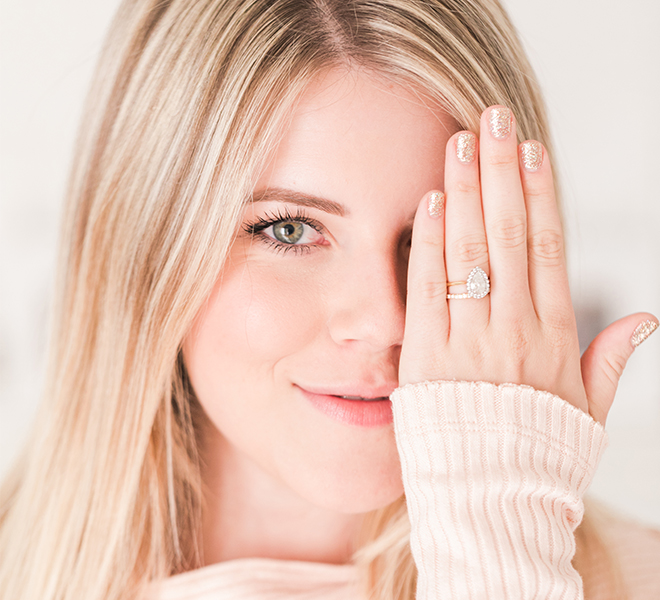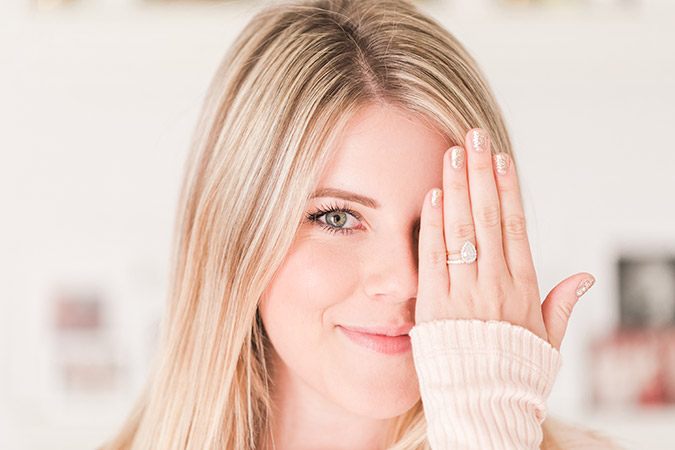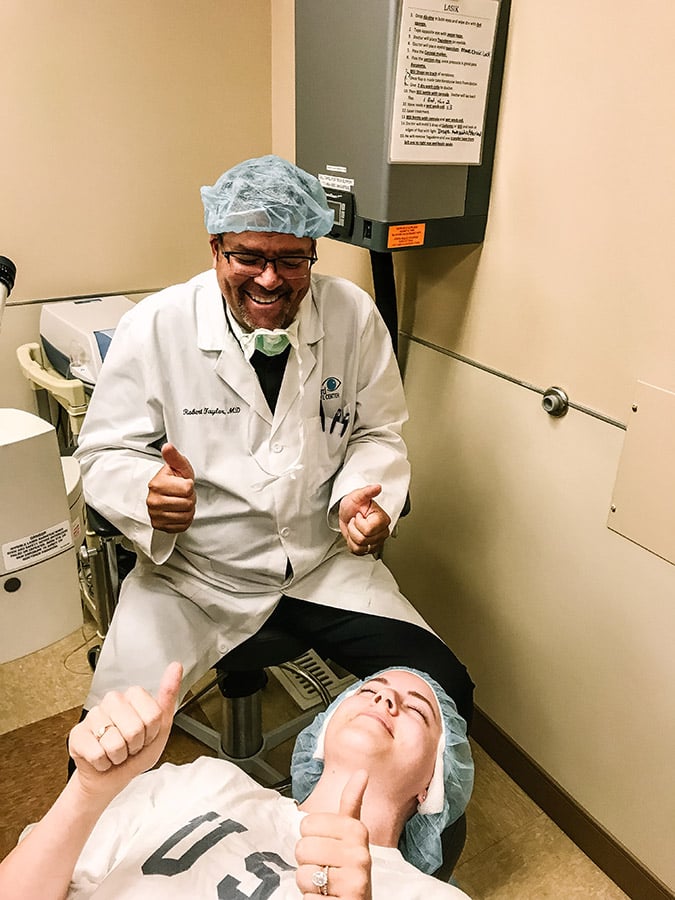Odds & Ends: My Laser Eye Surgery Diary

Hi there! It’s Tessa from Team LC. I grew up in a household where my dad, who is an ophthalmologist, tossed around medical terminology about the eye for as long as I can remember. But even so, the thought of getting laser eye surgery to correct my vision after about 13 years of wearing glasses and contacts made me a little bit nervous. Before my surgery I scoured the Internet for information (and of course asked my dad a million and one questions) about what to expect during and after the procedure. So, if you’re here because you are in the same boat, let me assure you… you’re not alone! Making the decision to have laser eye surgery—and then recovering afterward—can be an emotional rollercoaster, but it is one that is well worth it. (Promise!) I’m sharing my experience below, from pre- to post-op, so read on for my complete laser eye surgery diary…
What is Laser Eye Surgery?
Without getting too technical, there are a few different types of laser eye surgery out there, but two stand out as the most popular—LASIK and PRK. I made the decision to have PRK done instead of LASIK (I’ll explain why in a moment), and trusted my dad’s business partner Dr. Taylor at Shepherd Eye Center to do my surgery in my hometown of Las Vegas. In both LASIK and PRK, a laser is used to reshape the outer tissue of the eye, in order to produce clearer, crisper vision.

Before My Surgery
Before any laser equipment came anywhere near my eyes, I met with my doctor for a pre-op appointment to discuss my options, see if I was a candidate for surgery, and determine my current vision. As I mentioned briefly above, Dr. Taylor, my dad, and myself all agreed that PRK would be best route for me. Here’s a little bit about why…
In LASIK, a flap is created on the cornea and the tissue underneath is reshaped. In PRK—the procedure I chose—the surgeon removes a thin layer of the cornea altogether, reshapes the tissue, and the surface layer grows back and smooths out over time. (Full disclosure: PRK does have a longer recovery time and your vision improves over the the course of a few months until it is crystal clear, instead of just a few days like LASIK. However, I opted for PRK because I didn’t want to deal with the risk of a corneal flap becoming disconnected in the future if I was in an accident or my eyes got hit by an object.) That said, if you’re considering this surgery, always discuss your options with your doctor to decide what is best for you and your vision.
I scheduled my appointment for surgery, was asked to not wear my contacts for at least a week, and began the prescribed drops to prep for my procedure.
The Day Of
On the morning of my surgery, I simply plopped a few eyedrops into my eyes as directed, washed my face to make sure it was clear of any makeup or debris, and headed to the surgery center. After I arrived, I was given a surgical cap and booties, and a medication to help relax my nerves about 10 minutes before the surgery. Dr. Taylor brought me into the room along with my parents, numbed my eyes with a quick numbing drop, and got to work! The entire procedure was done in under 15 minutes, and I didn’t feel a single thing. (At the very most, I felt a bit of pressure on my eye every now and then, but it was nothing uncomfortable.) The doctor placed a “bandage” (basically a soft contact lens without any prescription) over each eye, and it was done.
Immediately afterward, the medical staff equipped me with plastic shields to go over my eyes, and a pair of large, extremely stylish (just kidding) sunglasses to help avoid any light sensitivity. For the first day I could see at about 75%, but I was forewarned that my vision would fluctuate over the next several weeks throughout the healing process. They sent me home to rest and I slept for a few hours—doctor’s orders!
 Immediately after surgery with Dr. Taylor.
Immediately after surgery with Dr. Taylor.
The First Week
2-3 Days Post-Op:
For the first few days, my eyes felt very dry. Let’s just say I relied heavily on tear drops—Dr. Taylor recommended I use them every hour for the first few weeks, and trust me when I say it was needed. But as far as pain goes, it was minimal and completely manageable. I was given numbing drops to use if the nerves in my eyes became too sensitive, but the good news is I only had to use them twice in the first week. During this time my vision was very blurry and hazy due to the epithelial layer of my eyes slowly healing.
4-5 Days Post-Op:
At the end of the first week, I went back to the clinic to have my contact bandage removed. It was as easy as removing a normal contact (which I was used to doing for several years before), so it was a cinch. However, having the smooth contact removed left a slightly gritty feeling in my eyes, since I was now blinking over tissue that was still healing and uneven. If anything, this stage was just annoying, but not painful. What I didn’t expect during the first week was how difficult it would be to see up close. I had to invert the colors on my phone just to read my texts, and stayed away from it almost completely until week two, just because it was so frustrating. But don’t worry—even this little annoyance went away soon enough and I was back to my regularly scheduled iPhone programming.
The Long Run
1-2 Weeks After Surgery:
After the first few days I wasn’t experiencing any pain at all, but my vision was still fluctuating day-to-day (in fact, it was even fluctuating hour-to-hour). I made sure to take off at least a week of work to give myself time to heal and rest, and didn’t attempt driving for about 7-10 days. It’s also not uncommon for your eyes to heal at different rates, so during this time my left eye became about 80% clear pretty quickly, but my right eye took a week or two longer to catch up. It was a unique time in the healing process because my vision would literally vary by the hour—oftentimes it was blurry in the morning, clear in the afternoon, then blurry again at night when my eyes got fatigued and dry. But those short glimpses of clear vision made me so excited for my final result, I knew it would be worth it all in the end.
At the end of the second week, my vision became noticeably clearer and my eyes started to balance out and “communicate” with one another to see normally. I was able to focus up close and far away pretty easily (it took a few seconds to focus every now and then), but it wasn’t quite perfect yet.
6-7 Weeks After Surgery:
Between six and seven weeks post-op, I went back to check my vision and lo and behold, I was seeing 20/20! In fact, in one eye I was even seeing better than 20/20. By this point I had no noticeable dryness, discomfort, or any blurriness.
6 Months After Surgery:
I’m now six months out from surgery, and having clear vision without the help of contacts or glasses is heaven-sent. I’ll admit the healing process (for PRK in particular) was a little bit more intensive than I had anticipated, but now I can’t even remember how I lived a life with the nuisance of glasses and contacts every day. Kicking those lenses to the curb and getting laser eye surgery was literally one of the best decisions I have ever made, and I can’t believe I get to wake up to perfect vision every day.
Have you ever thought about getting laser eye surgery? Or if you already have, how was your experience?
Tell me all about it below.
xx Tessa
Team LC
Photos: Jessi Burrone for LaurenConrad.com
Sources: WebMD
Affiliate links may have been used in this post.
